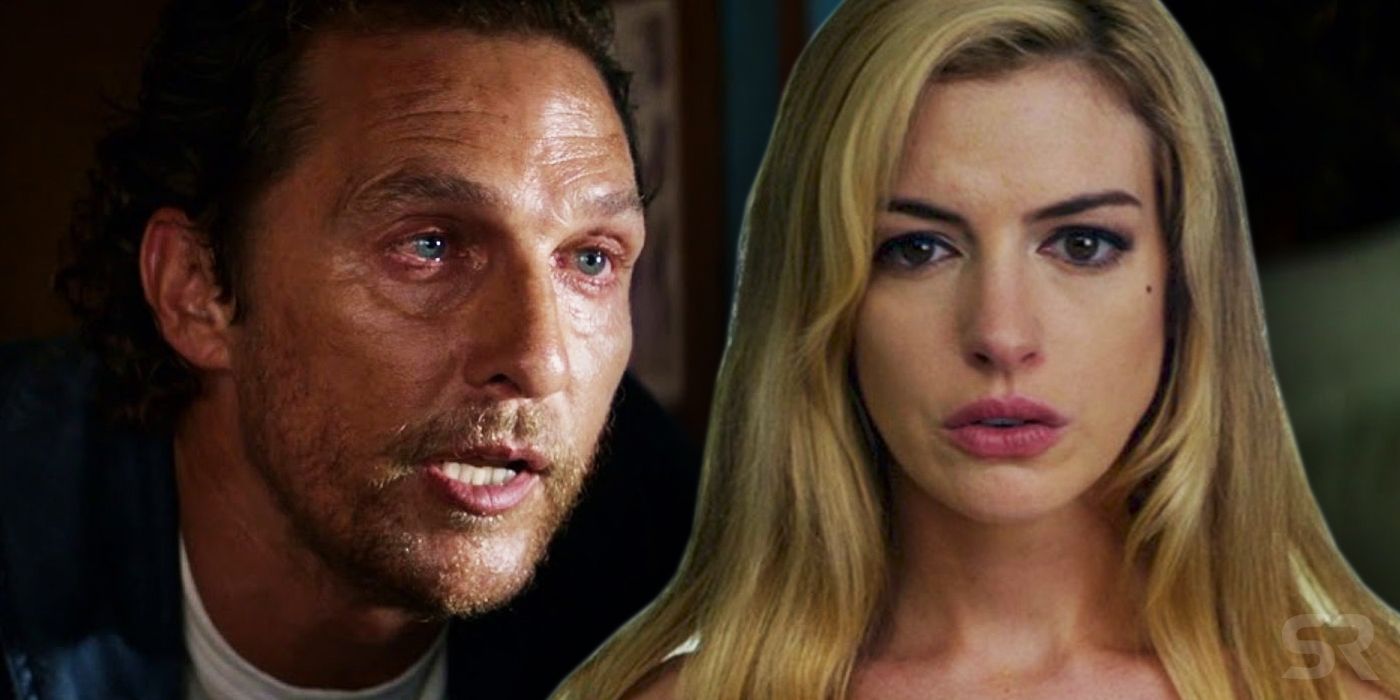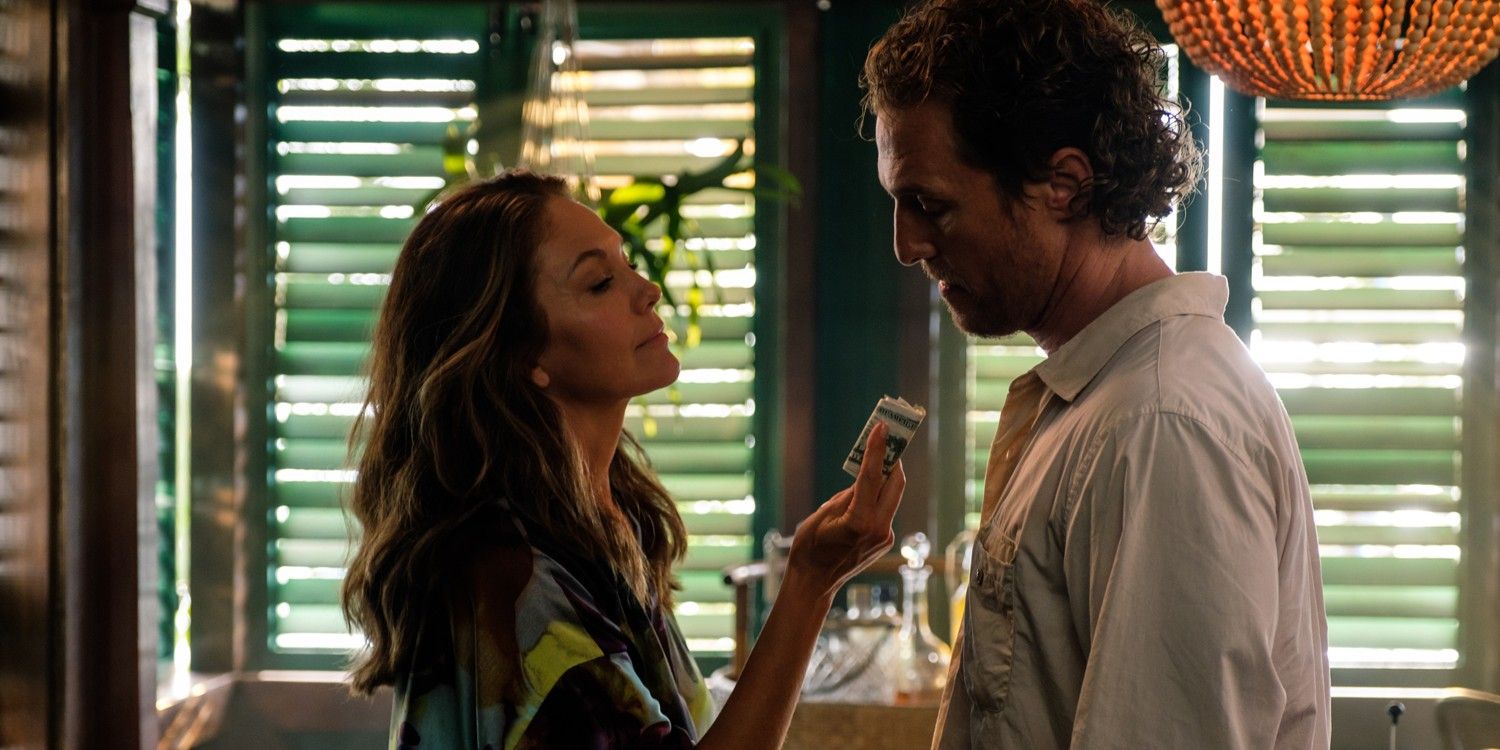WARNING: Spoilers for Serenity.
Serenity has one of the craziest endings ever. On the surface, Steven Knight’s lastest film appears to be a traditional thriller. However, a final act twist disrupts the narrative structure. From Eastern Promises to Locke to Peaky Blinders, Knight consistently keeps audiences guessing with his screenwriting, and Serenity is his latest film to subvert expectations.
Serenity begins with a close-up on the eyes of a young boy, a window into his soul, it seems. From there, the focus immediately shifts to Matthew McConaughey’s Baker Dill, a fishing guide who sabotages a client’s trip when he spots a giant tuna fish he’s named “Justice.” During Serenity's first half, a mysterious gentleman (Jeremy Strong) attempts to speak with Baker, but the fisherman is consistently on the go throughout Plymouth Island. Meanwhile, Baker's ex-wife Karen (Anne Hathaway) shows up and makes an offer he can’t quite refuse. For $10 million, she wants Baker to kill her abusive husband Frank (Jason Clarke) during a scheduled fishing clip. For Baker, he’s more interested in being a good father to his son, and speaking with him through telepathic means.
Related: Serenity Review: McConaughey's Noir Drama Goes Off the Deep End
Given Serenity’s traditional noir elements, the narrative suggests that Baker's free-will will likely determine the final outcome. However, the major twist is that Baker is being controlled by somebody else, and that Plymouth Island is a computer simulation. In this world, Serenity isn’t just a boat, and Justice isn’t merely a fish.
- This Page: What Happens In Serenity's Twist Ending?
- Page 2: How Serenity Set Up The Twist (& What The Ending Means)
SERENITY IS ABOUT A FISHING VIDEO GAME RE-CODED FOR REVENGE
Throughout Serenity, Baker speaks to his absent son, suggesting there’s a strong bond in place and that they will ultimately be reunited; a surrealistic image of Baker meeting with a boy underwater aligns with his story. Meanwhile, Baker's nemesis Frank speaks about his step-son, and how he likes to play video games, with the film repeatedly cutting away to an adolescent creating code in his room (while adults fight nearby). Two distinctly different men with two different sons, right?
Serenity’s wildcard comes in the form of Strong’s mysterious businessman, Reid Miller. During a night of heavy rain, he catches up with Baker and reveals a crucial bit of information after drinking some alcohol. His primary goal is to sell Baker a new piece of fishing equipment, but he’s first offering a free trial. When Baker presses Reid about his actual intentions, the businessman exclaims that “I am the rules.” Ultimately, Baker discovers that he’s living in a video game world created by Patrick (Rafael Sayegh), and that the primary objective is being changed. Baker's compulsion for fishing is merely a character trait, a piece of computer code. Patrick decides to drastically change “the rules,” in order to live out a fantasy of killing his abusive, real-life step-father. In the simulation, the now self-aware protagonist, Baker, is destabilized by the ever-changing code, unaware if he should fish or kill. Once Patrick completes the new code, Baker follows through with the command, in part aided by a new character who appears to be a simulated version of the video game creator - Patrick! On Serenity, Baker finds Justice. And Frank - the simulated version of Patrick's step-father - takes a final journey towards Justice.
But that’s not Serenity's final reveal: Baker's real-life inspiration, Patrick's father, is deceased. He was killed during military service in Iraq. Baker represents an idealized version of what might’ve been.
PATRICK KILLS HIS STEP-FATHER FOR REAL AT THE END OF SERENITY
For the majority of Serenity, Patrick uses free will in a world of his own creation. To the viewer, he may seem like a powerless kid, one forced to endure the violence taking place in the next room. Like many kids in similar situations, Patrick retreats into his personal "compulsion," thus transferring energy to the simulated version of his dead father. Through Baker, Patrick may watch his mother and father reunite. He may infuse his creative influences to manipulate a customized world.
Related: Matthew McConaughey & Anne Hathaway Interview: Serenity
But as the wiring of Patrick’s brain changes in Serenity, his creative concepts become a dark and twisted fantasy. Giving Baker free will to kill Frank isn’t enough. Instead, Patrick transfers Baker's power back to himself, in the real world, and the game's creator ultimately leaves his computer to find real-life justice. Serenity doesn’t end with Patrick’s real-life freedom, though he does experience salvation in his own mind (more on that later).
Page 2 of 2: How Serenity Set Up The Twist (& What The Ending Means)
THE FORESHADOWING OF SERENITY'S VIDEO GAME TWIST
From the very beginning, Serenity foreshadows it's taking place a simulated world. Of course, there’s the opening shot, in which the audience is taken into the mind of a young boy, Patrick. When Baker first appears, however, there’s no indication that what’s being presented on screen isn’t real. Baker appears to be just another grumpy fisherman, one who is passionate about his work. In that sense, Baker's introduction is universally relatable, as he fails while doing something he loves; he doesn't land the big catch, Justice.
In Serenity's subsequent land scenes, though, there's something a little off. The characters don’t seem to have much depth; they speak in cliches. Also, McConaughey’s character is repeatedly called by his full name, Baker Dill. In retrospect, the noir archetypes make sense because the characters aren't supposed to have much depth (aside from Baker); they’re just thinly-veiled versions of genre archetypes that Patrick has read about or seen: McConaughey as the Hero, Djimon Hounsou's Duke as the Sidekick, Hathaway as the Femme Fatale, Clarke as the Baddie, Diane Lane's Constance as the Idealized Love Interest.
In addition, Hathaway’s Karen references "the real world" when speaking about Facebook early on. At that point, Serenity suggests these characters live in a parallel world, subtle as it may be. While offering $10 million to Baker, Karen acknowledges the reason why she’s there: to make an offer her ex-husband can’t refuse (see The Godfather). Later, a supporting character tells Baker that he’s just in his own head, and Duke - the loyal friend - reinforces certain rules that Baker must live by. In this simulation, Baker does indeed have an Iraq backstory. And during a moment of reflection, he states that he "didn’t really come back." As Serenity progresses, it becomes evident that no one is supposed to die in Patrick’s simulation, which explains the collective character confusion when the creator begins working away on new code, all the while contemplating his own free will.
To complement the dialogue’s foreshadowing, Serenity uses visual motifs to at once support genre tropes while associating characters with specific colors. For example, Plymouth Island is full of bold reds, greens, whites, and blues; all of which match the design of Patrick’s room. When Baker begins to accept that he may indeed be part of a simulation, he asks someone about the island’s exact location in the world. In the subsequent phone call shot, the color scheme is red, white, and blue; matching Patrick’s geographical location, the United States of America.
Throughout Serenity, Baker is coded in blue. He’s a conflicted Aquaman in this story, associated with the ocean (and the blues). As for Frank, he wears primarily dark colors because he’s the villain. Lane’s character, coded in red and green, seems to reflect an unfinished version of Patrick's mother, while Hathaway’s femme fatale represents the idealized version. To further emphasize the noir elements, and to foreshadow death, Serenity uses the “X” visual motif - a technique that was famously used in the original 1932 Scarface (among various other noirs), along with a modern film like The Departed.
WHAT SERENITY'S ENDING REALLY MEANS
In Serenity's ending sequence, the writer-director Knight pays homage to the film's genre influences while making a bigger statement. When Baker speaks with his son on the phone, the scene is once again color-coded and includes the X motif. This is where Serenity allows for various interpretations, depending on the viewer's personal experiences. On one level, Serenity’s ending appears to suggest that Patrick has accepted his father’s death, which in turn correlates with new beginnings and life itself. When the two meet on a dock in the final shot, Patrick wears a bold red shirt and Baker now wears a bold blue one. The implications are that Patrick isn’t out of the water, so to speak, he definitely has legal problems (red symbolizes trouble). And for Baker, there’s a sense of clarity, evidenced by a solid shade of blue. Most importantly, the two are together, surrounded by a bright white light.
Serenity also raises questions about simulation theory, the idea that our current world is being controlled by a higher power, a technological God. Author Chuck Klosterman articulately addresses this concept in his 2016 book But What If We're Wrong?: Thinking About the Present As If It Were the Past, in which he discusses the idea that maybe life as we know it is merely the creation of a kid like Serenity's Patrick, someone living in the future playing out various simulations and fantasies. Justice comes in many forms, and Serenity can mean many things.






